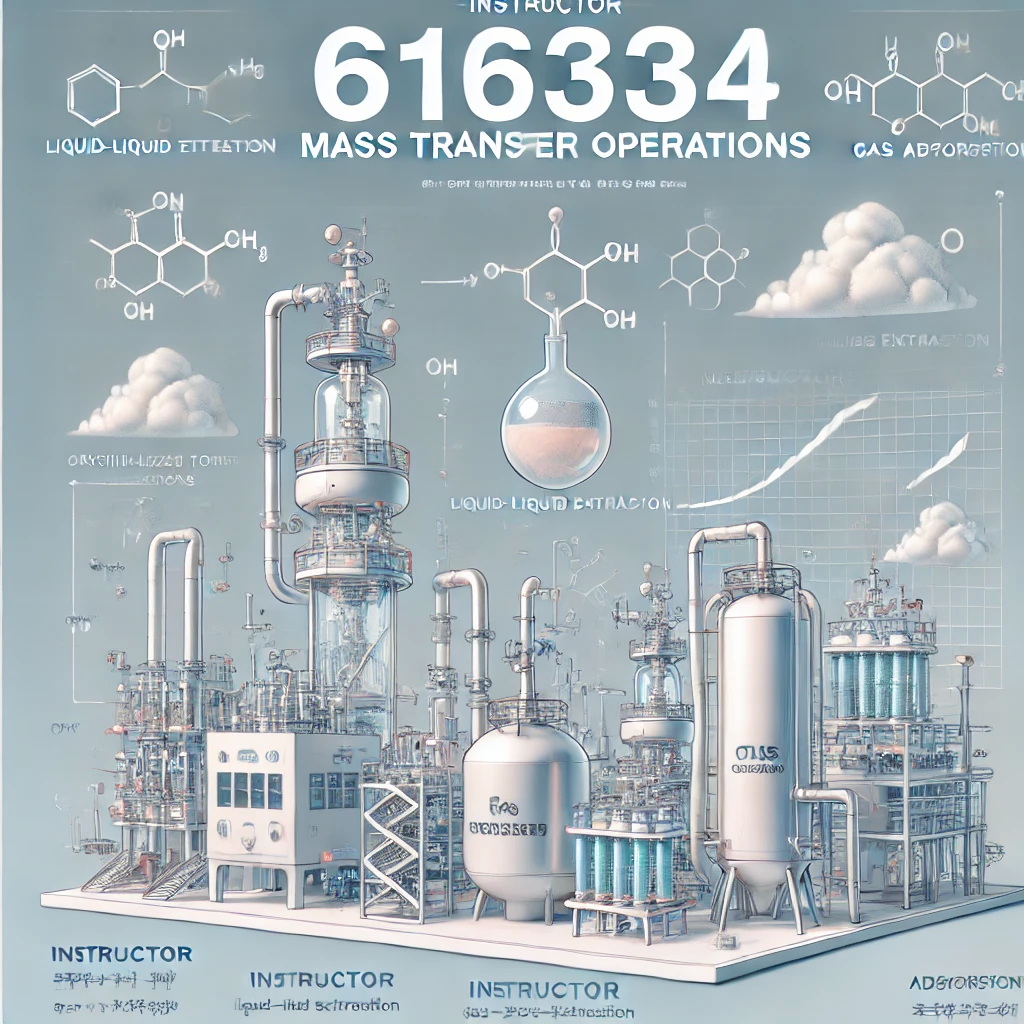การออกแบบและการกำหนดขนาดเครื่องแลกเปลี่ยนความร้อน เครื่องเพิ่มความชื้นและลดความชื้น การ
แยกด้วยหลักการใช้สิ่งกีดขวางและของแข็งโดยเน้นการแยกด้วยเยื่อแผ่นและกระบวนการดูดซับ การแยกที่
เกี่ยวกับวัฏภาคของแข็งโดยเน้นวิธีการชะล้าง การตกผลึก และการอบแห้ง การเลือกและการออกแบบเครื่องแยก
สำหรับของไหลผสมที่เป็นเนื้อเดียว
Heat exchanger design and sizing. Humidifiers and dehumidifiers. Separation by barriers and
solid agents with the emphasis on membrane separation and sorption processes. Separation
involving solid phase with the emphasis on leaching, crystallization, and drying. Selection and
design of separators for homogeneous fluid mixtures.
- Teacher: ผศ.ดร.วีรวัฒน์ ปัตทวีคงคา
การออกแบบเครื่องปั่นกวน แพ็คเบด และฟลูอิไดซ์เบด หลักการแยกทางกายภาพ การ ออกแบบกระบวนการแยกทางกลโดยเน๎นกระบวนการการกรอง การตกตะกอน การแยกโดยใช๎แรงโน๎มถํวงและแรงเหวี่ยง การคัดขนาดอนุภาค และการแยกอนุภาคจากแก๏ส
Design of agitator, packed and fluidized beds. Principles of physical separation. Design of mechanical-separation processes with the emphasis on filtration, sedimentation, gravity and centrifugal separation. Particle sieving and particle separation from gas.
- Teacher: ผศ.ดร.วีรวัฒน์ ปัตทวีคงคา
สารประกอบอินทรีย์ อนินทรีย์ และโลหะอินทรีย์ที่สำคัญในอุตสาหกรรมเคมี แนะนำกระบวนการผลิตในอุตสาหกรรมเคมี โดยเน้นวัตถุดิบ ส่วนสนับสนุนกระบวนการ อุปกรณ์และปฏิกิริยาเคมี การใช้แผนภาพการไหลของกระบวนการ ตัวอย่างของอุตสาหกรรมเคมี
Important organic, inorganic, and organometallic compounds in chemical industry. Introduction to manufacturing processes in chemical industry with the emphasis on raw materials, process utilities, equipments, and chemical reactions. Uses of process flow diagram. Examples of chemical industry.
- ผู้ช่วยศาสตราจารย์ ดร.วีรวัฒน์ ปัตทวีคงคา: ผศ.ดร.วีรวัฒน์ ปัตทวีคงคา
สารประกอบอินทรีย์ อนินทรีย์ และโลหะอินทรีย์ที่สำคัญในอุตสาหกรรมเคมี แนะนำกระบวนการผลิตในอุตสาหกรรมเคมี โดยเน้นวัตถุดิบ ส่วนสนับสนุนกระบวนการ อุปกรณ์และปฏิกิริยาเคมี การใช้แผนภาพการไหลของกระบวนการ ตัวอย่างของอุตสาหกรรมเคมีในภูมิภาค
Introduction to manufacturing processes in chemical industries with the emphasis on raw materials, process utilities, equipments, and chemical reactions. Uses of process flow diagram. Regional examples of chemical industries.
- Teacher: ผศ.ดร.วีรวัฒน์ ปัตทวีคงคา
สมบัติทางกายภาพของของไหล สถิตยศาสตร์ของของไหลและการประยุกต์ ชนิดของการไหล แรงต้านการไหล แฟกเตอร์ความเสียดทาน สมการอนุรักษ์โมเมนตัม การขนส่งของไหลผ่านท่อ วาล์ว และข้อต่อ การขนส่งอนุภาค ปั๊ม เครื่องอัดแก๊ส กังหัน เครื่องมือสำหรับวัดการไหล อุณหภูมิ ความดัน และระดับ การวัดสมบัติทางอุณหพลศาสตร์และสมบัติการนำพา
Physical properties of fluids. Fluid statics and application. Types of flow. Fluid drag force. Friction factor. Equations of momentum conservation. Transportation of fluid through pipes, valves and fittings. Transportation of powder. Pumps. Compressors. Turbines. Instruments for measurement of flow, temperature, pressure and level. Measurement of thermodynamic and transport properties.
- Teacher: ผศ.ดร.วีรวัฒน์ ปัตทวีคงคา
หลักการและกลไกพื้นฐานสำหรับการถ่ายเทมวล การแพร่เชิงโมเลกุลในแก๊ส ของเหลว และของแข็ง การถ่ายเทมวลระหว่างวัฏภาค แบบจำลองทางกายภาพสำหรับการปฏิบัติการการถ่ายเทมวล การประยุกต์ใช้แบบจำลองเหล่านี้ในการออกแบบกระบวนการแยกที่เกี่ยวข้องกับการดูดซึม การสกัด และการกลั่นแบบหลายสาร การกลั่นแบบกะ การแยกด้วยเยื่อแผ่น การการดูดซับ การชะละลาย การตกผลึก
Basic principles and mechanisms for heat and mass transfer. Molecular diffusion in gases, liquids and solids. Interphase mass transfer. Physical models for mass transfer. Applications of these models in the design of separation processes including multi-component absorption, extraction and distillation. Batch distillation. Membrane separation. Adsorption. Leaching. Crystallization.

- Teacher: ผศ.ดร.วีรวัฒน์ ปัตทวีคงคา
อดีต ปัจจุบัน และอนาคตของวิศวกรรมเคมี บทบาทและความสำคัญของวิทยาศาสตร์พื้นฐานในวิศวกรรมเคมี วิชาหลักและการประยุกต์ทางวิศวกรรมเคมี สาขาเชี่ยวชาญทางวิศวกรรมเคมี ความหลากหลายของอาชีพทางวิศวกรรมเคมี กฎหมายและจรรยาบรรณวิชาชีพ
Past, present, and future of chemical engineering. Role and importance of basic science in chemical engineering. Chemical engineering core subjects and applications. Chemical engineers’ areas of expertise. Career diversities in chemical engineering. Law and professional ethics.
- Teacher: ผศ.ดร.วีรวัฒน์ ปัตทวีคงคา
หลักการของการผุกร่อน กระบวนการเกิดขั้วบวกและขั้วลบ จุดเริ่มต้น และลักษณะการไหลของกระแสในการผุกร่อน ตารางมาตรฐานลำดับขั้นทางเคมีไฟฟ้าของโลหะ ความเฉื่อยของโลหะต่อการผุกร่อนและฟิล์มป้องกัน ผลกระทบของสิ่งแวดล้อมต่ออัตราการผุกร่อน รูปแบบของการผุกร่อน วิธีการลดหรือการป้องกันการ ผุกร่อน วัสดุป้องกันการผุกร่อนในอุตสาหกรรมเคมี การป้องกันแบบแคโธดิก บทบาทของสารยับยั้งปฏิกิริยา สารเคลือบและอโลหะที่ใช้ป้องกันการผุกร่อน
Principles of corrosion. Anode and cathode processes. Origin and characteristic of corrosion currents. Standard electrochemical series. Passivity and protective films. Effects of environment on corrosion rate. Forms of corrosion. Measures to minimize or prevent the corrosion. Protective materials in chemical plants. Cathodic protection. Roles of inhibitors, coating and non-metallic in combating corrosion.
- Teacher: ผศ.ดร.วีรวัฒน์ ปัตทวีคงคา
เงื่อนไข: รายวิชานี้วัดผลโดยกำหนดค่า S หรือ U (สำหรับนักศึกษาแบบ 1.2 และแบบ 2.2) การอ่านบทความอย่างเข้าใจและการประมวลข้อมูลจากสิ่งพิมพ์ที่น่าสนใจและทันสมัยในหัวข้อต่างๆ ในสาขาวิชาวิศวกรรมเคมี
Comprehensive reading and compilation of interesting current information. on Chemical Engineering.
- Teacher: ผศ.ดร.วีรวัฒน์ ปัตทวีคงคา
